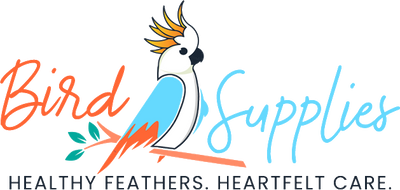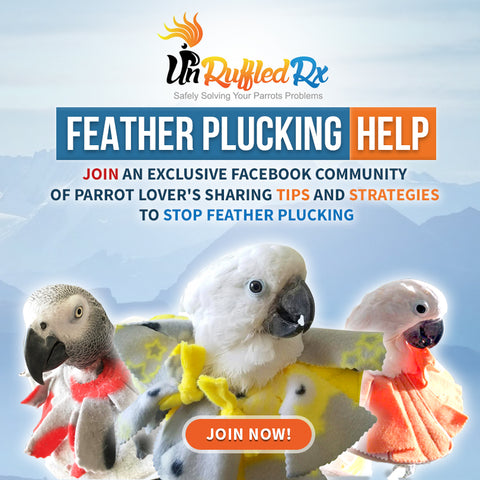
Feather picking, mutilation and other feather destructive behaviors (FDB) are an extremely worrisome problem for parrot owners. There are multitudes of medical, behavioral, nutritional, and environmental causes for this, and it is important to remember that the problem is rarely the result of one single cause. What's worse is that feather destructive behavior tends to get progressively worse with time. Whatever the original cause, simple FDB can an obsessive-compulsive disorder (OCD) very quickly. Because FDB is a multifaceted disorder, there are several things you should do to discourage this behavior to slow or stop its progression.
First things first. Get your bird to a qualified avian vet for a thorough check-up. Don't feel guilty. Avian vets report that about half of their patients have one degree or another of feather destructive behavior.
Good Nutrition
A nutritional diet is essential for normal skin and feather development. Seed and nut based diets often lead to vitamin A deficiencies, low calcium and protein imbalances resulting in feather unhealthy feathers and other disorders. Feed a good quality pelleted diet supplemented with hearty green and orange vegetables, healthy fruits, and nuts and grains.

Regular Bathing
Even if your parrot is bald, it still needs regular bathing. Most parrot species originate from rainforest areas and their bodies are designed to need humidity. Bathing helps with this. Regular bathing cleans feathers and removes old, itchy skin cells. It gets rid of dirt and irritants, and washes away dander and dust, making for more normal preening experiences.
"Many birds will enjoy a "greens bath", where fresh clean greens (collard, turnip, mustard, etc.) are placed in a low-sided shallow dish or pie pan with 1/2 to 3/4 inches of water, and the bird is allowed to play in it." Even if your feather plucker hates baths, you can use clicker training techniques to desensitize its fears.

Some people purchase a shower perch and place their bird in the shower with them each day. It makes for great bonding time. Others simply mist their bird or put a large bowl in the sink to allow the bird to splash away the dirt. What ever method you choose, make it part of your routine. One note, don't let your bird become chilled. It's okay to blow your parrot dry in the winter. Just make sure to use the low setting and not allow tender skin to burn.
Remove Attention During Chewing/Plucking/Preening
Any attention that a bird gets while it is plucking or even just preening is a "no-no!" Your bird will perceive any form of attention, positive or negative as reinforcement for that behavior. Running to your bird all worried or screaming and yelling at your bird can be perceived as a "drama reward". You must teach yourself to completely ignore behavior that you DO NOT want to continue and reward safe behaviors that you like with attention and treats. This is called the extinction method. Reward your bird for dancing, playing and climbing. Not for plucking.
Provide Chewing Material
Even if you have your feather plucker covered with a bird collar, it still needs to preen and chew. Provide your bird with a variety of chewing materials from wood, bird safe cardboard and natural materials to fluffy, preenable toys like mop heads, fleece snugglies and rope based toys. Remember, provide that attention when your bird is playing! Not plucking.
Provide Environmental Enrichment
Parrot researches found that wild parrots spend approximately 50% of their waking hours foraging for food, 25% of their time interacting with their flock members, and 25% of their time preening and keeping their feathers in good condition. Foraging, interacting and preening are essential behaviors that all birds need. Our captive parrots, who have food easily available at all times don't get to forage. And, we as our parrots social outlet may unknowingly engage in behaviors that promote plucking. Show your parrot love by rewarding it for foraging and playing. Provide toys or feeding sites that encourage foraging behaviors,. Keep your parrot entertained with the radio or television, or even a video of you and it playing to keep it occupied when you're not around to interact with it.

Do Not Smoke Around Your Bird
Keep your bird away from cigarette smoke or any kind of smoke, for that matter! Not only is smoke a respiratory irritant, but it leaves a nasty residue on everything in the vicinity. The somewhat sticky residue gets on the hands and clothes even when they take it outside. Then it is transferred to the bird when handled.
Avoid Chemicals
Any aerosolized products, including air fresheners, incense, carpet fresheners, bleach, and cleaning solutions can also get on the feathers, irritate a bird's skin and lead to feather destructive behavior. A good rule of thumb is, "If you can smell it, then multiply it ten-fold for your bird, who has a highly developed respiratory system." Avoid using chemicals to clean your birds living environment and accessories. Opt for soapy water. If you must use a chemicals, be sure to thoroughly rinse anything that your bird may come into contact with.
Opt for Professional Wing Trims
Aggressive wing trims, or leaving trimmed feathers too long, rub and poke at the flanks and wings. Your bird may end up chewing at these areas to find relief. Vets recommend to allow wing feathers to grow with feather-destructive birds, but if escape is an issue, then trimming just the first 5-7 primary wing feathers under the level of the covert feathers. This helps pad the cut end of the feather and keep it from further traumatizing the bird's flank. Never trim new feathers.

In conclusion, even though feather destructive behavior is difficult to manage, let alone stop, there are a number of FREE things you can do to offer your bird comfort and decrease the desire to pluck.







